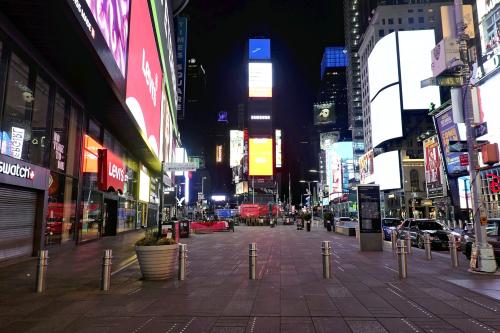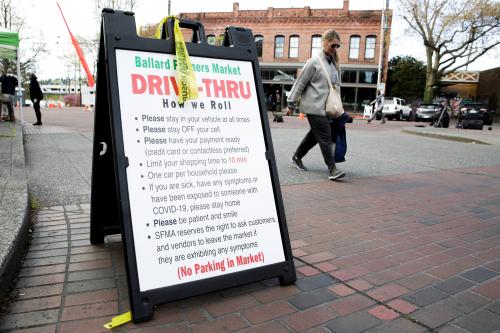Now that businesses are reopening, the most urgent issue is how to do it safely. Congress is now being asked to safeguard both businesses that want to reopen and the workers who are necessary for them to do so. Businesses, knowing that their employees or customers could get COVID-19, are asking for protection against lawsuits saying they’re responsible when that happens. Their employees, knowing the same, want protection for themselves and their families, too, when they go back to work.
At the moment, Congress is doing nothing while businesses are reopening, people are coming back to workplaces they know are risky, and there will be lawsuits over who should pay for the illnesses, deaths, and other losses that occur.
What Congress could do, however, is to combine two proposals that are already on the table: protection against lawsuits and a “hazard pay bonus” for workers in workplaces that haven’t yet been tested and shown to be safe.
Advocates for each proposal believe their proposal is justified on its own. Advocates for hazard pay point out, accurately, that employers are forcing employees to work whether workplaces are safe or not; if employees refuse, in most states they get no unemployment benefits. Businesses advocating protection from lawsuits, for their part, note that they didn’t bring coronavirus in and that the cost of reconstructing stores and restaurants and rebuilding plants so that everyone is six feet apart in many cases is prohibitive.
Furthermore, each group of advocates thinks the other side’s proposal is unnecessary. Ironically, both sides argue instead for national workplace safety standards—worker advocates for strong ones and employers (implicitly) for weak ones. In practice, however, this approach hasn’t worked at all. Nor, given the dismal performance of federal regulators to date and that reopening is already occurring, is it realistic to think it will.
What could work, however, is a Congressional compromise that incorporated both. If Congress could, once again, compromise, we could reopen the economy while protecting both businesses and workers—and speed our recovery from the pandemic.
We’re reopening but not to anyone’s safety plan: Some unpleasant facts
Both employers and unions and other worker advocates argue for national safety standards. But unfortunately the nation’s government has produced no real safety standards that either businesses or workers can rely on—nor is it clear when, if ever, it can or will. The initial CDC/OSHA “interim guidance” was a collection of loophole-ridden suggestions that OSHA said had no legal standing. Furthermore, OSHA announced that any workplace requirements that do apply, such as PPE and the general obligation to provide a safe workplace, will be enforced “flexib[ly]” (i.e., they may not be enforced at all).[1]
Although there have been many calls for nationwide enforceable emergency workplace OSHA safety standards, OSHA and CDC have repeatedly failed to produce them. As has widely been reported, CDC and OSHA tried to develop a set of “guidelines” for reopening, but the White House disapproved and sent them back to the drawing board. After widespread criticism, CDC/OSHA published more specific guidelines for general business, manufacturing and meatpacking. However, neither they nor the more detailed unreleased draft provides much actual workplace protection. Among their shortcomings:
- For most businesses, except for temperature checks, they don’t even mention testing. (For schools and meat processing plants, they now recommend “consider[ing]” testing. The draft guidance that was revoked prescribed COVID testing only for workers who already show symptoms.[2]) Workers who hide their fevers to keep their paychecks could continue to infect both customers and fellow workers.
- They would “encourage”, but not require, face covering[3] and social distancing “if appropriate”.
- They suggest, but don’t require, that “general workplaces…ensure strict social distancing, proper cleaning and disinfecting, and protection of their workers and customers.” In some cases, this is easy; in others not: reconfiguring an office is a lot easier in offices than in restaurant kitchens or on an assembly line. What’s feasible will depend on the particulars of each industry and, in some cases, each workplace.
To be clear, OSHA isn’t enforcing even these weak guidelines. Instead, it announced and said it will enforce—subject to “resource limitations” and allowing OSHA personnel to avoid actually visiting worksites—a much more limited requirement: employers must report “work-related” COVID deaths or hospitalizations if the employer knows about them and decides they’re work related. There’s no testing requirement and OSHA said it will generally accept an employer’s judgment about whether cases are work-related.
In this pandemic OSHA seems both unprepared and unwilling to do its job. Safety will have to come from elsewhere.
How to get businesses to implement safety without federal regulation? Temporary hazard pay
Since workable federal safety standards are unlikely, and certainly won’t happen immediately, the challenge is to put in place some protections now but also to encourage employers to improve workplace safety on their own. One way to do this is to recognize that, at least for now, workers called back in to work are taking risks and—until workplace tests prove the risk is over and life returns to normal—they should get hazard pay.
The concept is simple. Essential workers are being asked to risk their lives and their families. There’s no time to do millions of individual salary negotiations, so blanket compensation increases—paid for by a combination of business and government—should be required. House Democrats made hazard pay the named centerpiece of their “HEROES Act,” but support is by no means limited to Democrats: Sen. Romney (R-UT) and even the libertarians at the Niskanen Center have both endorsed the idea (though they’d call it “patriot pay”). Most of these proposals focus on those who work in health care institutions or first responders. However, in reopening the economy the way we’re doing it—with no real safety requirements and without any way of knowing who’s infected—we’re turning most workers into “essential workers” and exposing millions more to COVID risks.
Here’s how this could work: until there’s testing and certification that a workplace is COVID-free, workers should get a federally-subsidized “patriot pay” bonus—Senator Romney suggested $12 per hour up to some limit—in addition to COVID-related healthcare coverage and paid sick leave. The federal government would pay its shares of the bonus (Senator Romney suggests 75%), and of health insurance and sick leave directly to employers by using the IRS payroll tax system in reverse. Once a workplace can show via actual testing that it has been COVID-free for at least several months, the employer obligations and the federal subsidies would phase out.
There are, to be sure, a myriad of implementation issues: e.g., how to ensure that workers who telework aren’t covered, that the federal payments actually get paid to workers as bonuses, how to combine the program with some limited immediate safety measures (e.g., masks), etc.
A compromise would help businesses, workers, and the nation to recover
Nonetheless, this approach has many benefits. First, it would provide liability protection for employers, but also a clear incentive for them both to implement sensible safety measures and to test. Second, it rewards employees with substantially higher pay for the workplace risks that they, through no fault of their own, must bear. Third, some of the components, e.g., sick leave and health insurance coverage of COVID, have already become COVID legislation, although they clearly would have to be modified. Last, but perhaps most important, it could help tens of millions get back to work and get a reliable paycheck instead of staying out and waiting for unemployment.
There’s already support, even among some Democrats, for some limits to COVID-related lawsuits. Liability protection against patient lawsuits has already been legislated for some healthcare institutions and has been proposed for more. But there cannot and should not be general liability protection from employee lawsuits or lawsuits generally unless and until there are both some immediate safety measures (e.g., masks) and a “patriot bonus” that encourages employers to make workplaces safe—and lasts until they actually are.
Like most compromise proposals, this combination will satisfy no one. But it might enable us to maintain public health, speed our economic recovery, and recognize the millions who go back to work while the coronavirus is unchecked as the patriots they are.
[1] “OSHA recognizes that employers in many sectors may experience challenges in complying with certain provisions of the agency’s standards as a result of the COVID-19 pandemic, including where those standards require the use of certain types of PPE (e.g., respirators) or provision of medical surveillance and training to workers. Accordingly, OSHA is providing enforcement flexibilities for specific provisions of certain standards and requirements to address these challenges and help ensure the continued protection of worker safety and health.” From the OSHA website accessed May 14, 2020. https://www.osha.gov/SLTC/covid-19/standards.html#enforcement_discretion
[2] CDC Draft Guidance, p. 8. The “Workplace Decision Tree” issued May 14, 2020.
[3] Ibid., p. 17







Commentary
To reopen the economy safely, we need both liability protection and hazard pay
May 21, 2020